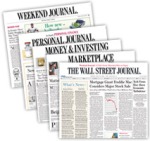By LIAM PLEVEN
Exchange-traded funds have lured many investors away from mutual funds by offering lower fees. But increasingly, some ETFs are also using fees to compete with other ETFs.
In a handful of high-profile cases, particularly in commodities and stocks, investors can choose between two ETFs that are virtually identical except for their fees. Gold bugs, for instance, can buy into a bar of bullion by holding shares in either SPDR Gold Shares GLD +3.88% or iShares Gold Trust IAU +3.94% . But the SPDR fund charges 0.4% of assets a year in fees, compared with the iShares fund’s 0.25%.
Disparities like that point to the rising importance of price as a distinguishing factor in what has become a crowded and confusing ETF marketplace for many individual investors. It isn’t clear yet how effective the tactic will be in the long run—there may be good reasons in some cases for investors to stick with or buy a higher-priced fund. But it seems to hold promise as a marketing tool.

 “You saw some competition on price really start to work” last year, when some of the more-expensive ETFs, including SPDR Gold Shares, saw net outflows of investor funds while lower-priced competitors, including iShares Gold Trust, saw money come in, says Matt Hougan, president of ETF analytics at IndexUniverse.com.
“You saw some competition on price really start to work” last year, when some of the more-expensive ETFs, including SPDR Gold Shares, saw net outflows of investor funds while lower-priced competitors, including iShares Gold Trust, saw money come in, says Matt Hougan, president of ETF analytics at IndexUniverse.com.
He says the strategy could spread if investors start to show a clear preference for even small savings.
Playing Catch-Up
Lower costs could be critical for companies that aren’t the first to launch an ETF in a particular market niche. When the ETFS Physical Silver Shares SIVR +2.50% fund started in 2009, three years after iShares Silver Trust, SLV +2.45% “we were playing a little bit of catch-up,” says Tim Harvey, a senior vice president at the newer fund’s manager, ETF Securities. ETFS Physical Silver charges 0.3% in annual fees, compared with 0.5% for the iShares fund. “From a marketing point of view,” says Mr. Harvey, the lower fee “definitely helps.”
Dueling stock ETFs include two emerging-markets funds that track the same index and even have names that are hard to tell apart: Vanguard MSCI Emerging Markets ETF, VWO -2.47% or VWO, costs 0.2%, compared with 0.67% for iShares MSCI Emerging Markets Index, EEM -2.68% or EEM.
And Charles Schwab Corp. SCHW -2.89% has rolled out a slate of ETFs in recent years that are similar or identical to funds offered by competitors—highlighting on its website that “in many cases” the expenses are lower than those of “comparable” iShares funds from BlackRock Inc. BLK -2.48% or SPDR offerings from State Street Corp.’s STT -3.23% State Street Global Advisors.
For instance, Schwab U.S. Large-Cap ETF SCHX -2.56% tracks the same index as the much smaller SPDR Dow Jones Large Cap, ELR -2.41% with lower fees—0.08% for the Schwab fund to 0.2% for the SPDR fund.
Even if investors are drawn to lower fees, though, there’s more to consider when comparing nearly identical ETFs. For one thing, cashing out of a fund just to shift their money to a lower-priced competitor could backfire if the sale triggers a tax bill on any gains from the first fund.
Sometimes Pricier Pays
For people looking to invest new money, higher fees may be worth it in some cases. SPDR Gold Shares and iShares Silver Trust are more appealing to active traders than their lower-fee competitors because the pricier funds are so much bigger, says Phil Blancato, chief executive of New York-based Ladenburg Thalmann Asset Management, a Ladenburg Thalmann Financial Services Inc. LTS -3.42% unit that manages about $1.1 billion in client assets.
SPDR Gold Shares has $64 billion in assets, compared with iShares Gold Trust’s $9 billion, according to fund tracker Morningstar Inc., MORN -1.20% while the iShares Silver Trust’s $9 billion in assets overshadows ETFS Physical Silver’s $485 million. The result is that there can be more shares of the more-expensive funds changing hands every day and narrower differences between what a seller wants to get and a buyer wants to pay, says Mr. Blancato.
But if investors plan to hold shares for a year or longer, he says, then the advantage of lower fees looms larger. Over three years, for instance, the annualized return on SPDR Gold Shares is 16.37%, compared with 16.47% for iShares Gold Trust, according to Morningstar. “That’s why we go with IAU,” the iShares ETF, as a recommended fund, says Abraham Bailin, a Morningstar analyst.
State Street saw an impact on SPDR Gold from iShares Gold Trust’s marketing around lower fees “initially,” says Kevin Quigg, State Street’s global head of strategy. But, he says, “we don’t feel we’re experiencing outflows because of it.” This year, both funds have seen net inflows, with SPDR Gold gaining more than three times as much new investment as iShares Gold Trust, according to Morningstar.
Stocks Can Get Fuzzy
With stock funds, the impact of price differences can be less clear. That’s because ETFs that track the same index can use different portfolios to do so, meaning their returns can deviate slightly aside from any fee discrepancy.
Between the two emerging-markets ETFs, Vanguard Group Inc.’s VWO—which is both cheaper and larger than iShares’ EEM—has generated a negative 0.5% return in 2012, through May, compared with negative 0.63% for its rival, according to Morningstar.
Fund providers haven’t locked themselves into any pricing strategy at this point. Often they price some of their ETFs lower than those of competitors and some higher.
In the end, the competition is “a good thing for the investor,” says John Woerth, a Vanguard spokesman. “They’re getting a better deal.”
Mr. Pleven is a staff reporter for The Wall Street Journal in New York. Email him at liam.pleven@wsj.com.

